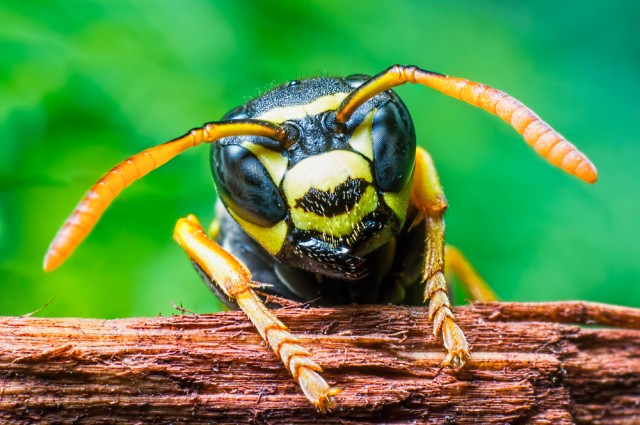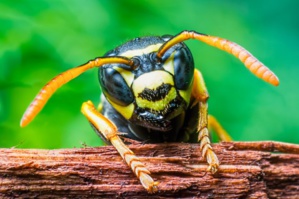The Biophysical Journal publishes a report which shows that the “painful” sting of wasp whereby they inject their venom in the body has “shown to attack cancer cells while leaving healthy cells alone”. The toxin of wasp that targets cancer is known as “MP1 (Polybia-MP1)”, whose anti carcinogenic properties were unknown. The new research shows that the venom “exploits the atypical arrangement of fats, or lipids, in cancer cell membranes”. They have an abnormal distribution “creates” weak points on the membrane through which the toxin and lipid interaction takes place.
At this stage, many a gaping hole appears on the cancerous membrane. Consequently, many large “essential molecules” like proteins then leaks out of the cell body and without them the cells are left dysfunctional.
The wasp which produces this particular toxin is called the “Polybia paulista”. The toxin has been “tested on model membranes” which was then examined through “a broad range of imaging techniques”. The co-author of the study, Leeds’ University’s Paul Beales informs:
"Cancer therapies that attack the lipid composition of the cell membrane would be an entirely new class of anticancer drugs. This could be useful in developing new combination therapies, where multiple drugs are used simultaneously to treat a cancer by attacking different parts of the cancer cells at the same time."
When it comes to the healthy cells the inner walls are layered with “phospholipids, including PS (phosphatidylserine) and PE (phosphatidylethanolamine)” while the carcinogenic ones have the reverse disposition as the “PS and PE are located on the outer layer of the cell membrane”. The scientists studied the interaction of MP1 with model membranes which were “infused with PE and/or PS”. This was done to examine the various “effects of PS and PE's presence on a cell”. The result observed was that in seven cases out of eight the presence of PS in a membrane increased the chances of MP1 binding with it, while the PE effect “inflated the size of the holes created by the MP1 by a factor 20 to 30”. Another co-author of the study João Ruggiero Neto, who is from “São Paulo State University” informs that:
"Formed in only seconds, these large pores are big enough to allow critical molecules such as RNA and proteins to easily escape cells. The dramatic enhancement of the permeabilization induced by the peptide in the presence of PE and the dimensions of the pores in these membranes was surprising."
Talking about the next step for research, Beales states:
"Understanding the mechanism of action of this peptide will help in translational studies to further assess the potential for this peptide to be used in medicine. As it has been shown to be selective to cancer cells and non-toxic to normal cells in the lab, this peptide has the potential to be safe, but further work would be required to prove that."
References:
http://www.iflscience.com
At this stage, many a gaping hole appears on the cancerous membrane. Consequently, many large “essential molecules” like proteins then leaks out of the cell body and without them the cells are left dysfunctional.
The wasp which produces this particular toxin is called the “Polybia paulista”. The toxin has been “tested on model membranes” which was then examined through “a broad range of imaging techniques”. The co-author of the study, Leeds’ University’s Paul Beales informs:
"Cancer therapies that attack the lipid composition of the cell membrane would be an entirely new class of anticancer drugs. This could be useful in developing new combination therapies, where multiple drugs are used simultaneously to treat a cancer by attacking different parts of the cancer cells at the same time."
When it comes to the healthy cells the inner walls are layered with “phospholipids, including PS (phosphatidylserine) and PE (phosphatidylethanolamine)” while the carcinogenic ones have the reverse disposition as the “PS and PE are located on the outer layer of the cell membrane”. The scientists studied the interaction of MP1 with model membranes which were “infused with PE and/or PS”. This was done to examine the various “effects of PS and PE's presence on a cell”. The result observed was that in seven cases out of eight the presence of PS in a membrane increased the chances of MP1 binding with it, while the PE effect “inflated the size of the holes created by the MP1 by a factor 20 to 30”. Another co-author of the study João Ruggiero Neto, who is from “São Paulo State University” informs that:
"Formed in only seconds, these large pores are big enough to allow critical molecules such as RNA and proteins to easily escape cells. The dramatic enhancement of the permeabilization induced by the peptide in the presence of PE and the dimensions of the pores in these membranes was surprising."
Talking about the next step for research, Beales states:
"Understanding the mechanism of action of this peptide will help in translational studies to further assess the potential for this peptide to be used in medicine. As it has been shown to be selective to cancer cells and non-toxic to normal cells in the lab, this peptide has the potential to be safe, but further work would be required to prove that."
References:
http://www.iflscience.com






